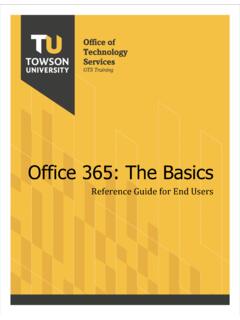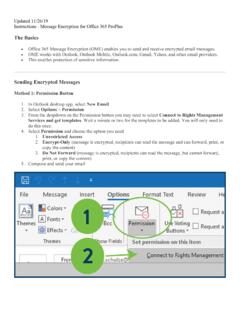Transcription of Email Authentication Best Practices The Optimal Ways To ...
1 Email Authentication Best Practices The Optimal Ways To Deploy SPF, DKIM And DMARC Hrvoje Dogan Technical Marketing Engineer Security Business Group Revision 4, August 1, 2017 TABLE OF CONTENTS INTRODUCTION 3 Product knowledge requirements 3 Email Authentication A SHORT OVERVIEW 4 Sender Policy Framework 4 Domain Keys Identified Mail 5 Domain-based Message Authentication , Reporting And Conformance 6 SPF DEPLOYMENT CONSIDERATIONS 7 SPF For Receivers 7 If You Provide Email Services For Other Domains Or 3rd Parties 8 If You Use 3rd Party Email Services 9 (Sub)Domains with No Email Traffic 9 DKIM DEPLOYMENT CONSIDERATIONS 10 DKIM For Receivers 10 Preparing to sign with DKIM 11 If You Use 3rd Party Email Services 12 DMARC DEPLOYMENT CONSIDERATIONS 12 DMARC For Receivers 12 If You Provide Email Services For Other Domains Or 3rd Parties 13 If You Use 3rd Party Email Services 13 (Sub)Domains with No Email Traffic 13 DMARC-Specific Issues 14 SAMPLE ACTION PLAN TO IMPLEMENT Email Authentication 15 ADDITIONAL REFERENCES 17 2017 Cisco and/or its affiliates.
2 All rights reserved. 3 INTRODUCTION This paper describes three predominant Email Authentication technologies in use today, SPF, DKIM and DMARC, and discusses various aspects of their implementation. Several real-life Email architecture situations will be presented and discussed, along with guidelines on how to implement them on Cisco Email Security product set. Since this is a hands-on best Practices guide, some of the more complex material will be omitted. Also, where necessary, certain concepts may be simplified or condensed to ease understanding of presented matter. Product knowledge requirements This is an advanced level document.
3 To be able to follow through the material presented, reader should possess product knowledge of the Cisco Email Security Appliance to the level of Cisco Email Security Field Engineer certification. Furthermore, readers should have strong command of DNS and SMTP and their operation. Acquaintance with basics of SPF, DKIM and DMARC is a plus. 2017 Cisco and/or its affiliates. All rights reserved. 4 Email Authentication A SHORT OVERVIEW Sender Policy Framework Sender Policy Framework was first published in 2006, as RFC4408. Current version is specified in RFC7208 and updated in RFC7372. In essence, it provides a simple way for a Domain Owner to advertise their legitimate Email sources to the Receivers using DNS.
4 Although SPF primarily authenticates the return path (MAIL FROM) address, the specification recommends (and provides mechanism) to also authenticate SMTP HELO/EHLO argument (FQDN of sender s gateway as transmitted during SMTP conversation). SPF uses TXT type DNS Resource Records of fairly simple syntax: text = "v=spf1 mx a ip4 ~all" The Spirit Airlines record above allows Email from addresses to come from a particular /24 subnet, two machines identified by a FQDN, and Microsoft s office365 environment. The ~all qualifier at the end instructs receivers to consider any other sources as Soft Fail one of two failure modes of SPF.
5 Take note that senders do not specify what receivers should do with failing messages, just to which degree they will fail. Delta, on the other hand, employs a different SPF scheme: text = "v=spf1 -all" To minimize the number of DNS queries required, Delta created a single A record listing all of their SMTP gateways. They also provide a separate SPF record for their vendors in . They also include instructions to Hard Fail any messages not authenticated by SPF ( -all qualifier). We can further look up the vendors SPF record: text = "v=spf1 ?all" So, emails from senders may legitimately come from, for example, Air France s Email gateways.
6 United, on the other hand, uses a much simpler SPF scheme: text = "v=spf1 ip4 ip4 ip4 ip4 mx ~all" Other than their own corporate mail gateways, they include their Email marketing providers ( and ), legacy Continental Air Lines gateways, as well as everything listed in their MX records ( mx mechanism). Take note that MX (an incoming mail gateway for a domain) may not be the same as outgoing. While for smaller enterprises they will usually be the same, larger organizations will have separate infrastructure handling incoming mail, and separate handling outgoing delivery. Also, worth noting is that all of the above examples make extensive use of additional DNS referrals ( include mechanisms).
7 However, due to performance reasons, SPF specification limits 2017 Cisco and/or its affiliates. All rights reserved. 5 the total number of DNS lookups necessary to retrieve a final record to ten. Any SPF lookups with over 10 levels of DNS recursion will fail. Domain Keys Identified Mail DKIM, specified in RFCs 5585, 6376 and 5863 is a merge of two historic proposals: Yahoo s DomainKeys and Cisco s Identified Internet Mail. It provides a simple way for senders to cryptographically sign outgoing messages and include the signatures (along with other verification metadata) in an Email header ( DKIM-Signature ).
8 Senders publish their public key in the DNS, thus making it easy for any receivers to retrieve the key and verify signatures. DKIM does not authenticate the physical messages source, but relies on the fact that if source is in possession of the sender organization s private key, it is implicitly authorized to send Email on their behalf. To implement DKIM, sending organization would generate one or more public key pairs and publish the public keys in the DNS as TXT records. Each key pair would be referenced by a selector so DKIM verifiers can differentiate between keys. Outgoing messages would be signed, and DKIM-Signature header inserted: DKIM-Signature: v=1; a=rsa-sha1; c=relaxed/relaxed; s=united; d= ;h=MIME-Version:Content-Type:Content-Tra nsfer-Encoding:Date:To:From:Reply-To:Sub ject:List-Unsubscribe:Message-ID; bh=IBSWR4yzI1 PSRYtWLx4 SRDSWII4=; b=HrN5 QINgnXwqkx+Zc/9 VZys+yhikrP6wSZVu35KA0jfgYzhzSdfA2nA8D2 JYIFTNLO8j4 DGmKhH1 MMTyYgwYqT01rEwL0V8 MEY1 MzxTrzijkLPGqt/sK1 WZt9pBacEw1fMWRQLf3 BxZ3jaYtLoJMRwxtgoWdfHU35 CsFG2 CNYLo= The format of the signature is fairly straightforward.
9 A tag specifies algorithms used for signing, c specifies the canonicalization scheme(s) used1, s is the selector or key reference, d is the signing domain. The rest of this DKIM-Signature header is message specific: h lists signed headers, i lists signing user s identity, and finally the header ends with two separate hashes: bh is a hash of signed headers, while b is the hash value for body of the message. When receiving a DKIM-signed message, receiver will look up the public key by constructing the following DNS query: <selector>._domainkey.<signing domain> as specified in the DKIM-Signature header.
10 For the above example, our query would be : text = "g=*\; k=rsa\; n=" "Contact" "with" "any" "questions" "concerning" "this" "signing" "\; p=MIGfMA0 GCSqGSIb3 DQEBAQUAA4 GNADCBiQKBgQC/Vh/xq+sSRLhL5 CRU1drFTGMXX/Q2 KkWgl35hO4v6dTy5 Qmxcuv5 AwqxLiz9d0jBaxtuvYALjlGkxmk5 MemgAOcCr97 GlW7Cr11eLn87qdTmyE5 LevnTXxVDMjIfQJt6 OFzmw6Tp1t05 NPWh0 PbyUohZYt4qpcbiz9Kc3UB2 IBwIDAQAB\;" DNS record returned contains the key, as well as other optional The main problem with DKIM is that the initial specification did not allow for advertising that a sender uses DKIM. Thus, if a message comes without a signature, there is no easy way for a 1 Canonicalization is beyond the scope of this document.











